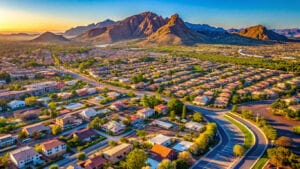Welcome to aging in Arizona. The desert doesn’t just challenge your air conditioning bill — it fast-tracks skin damage in ways most people don’t realize until it’s already happened.
Why Arizona Ages Your Skin Faster
Arizona’s environment creates a perfect storm for skin aging. The intense UV radiation at higher elevation, combined with bone-dry humidity levels and temperature swings that can hit 50 degrees in a single day, puts stress on your skin that most climates never match.
The sun here hits different — literally. Arizona sits higher up, so there’s less atmosphere filtering out the UV rays. You’re getting blasted with more intense radiation even when it’s cloudy. That “dry heat” people always mention? It’s constantly sucking moisture right out of your skin, breaking down the protective barrier that normally keeps you looking younger.
Then there’s dust. Valley residents deal with haboobs and constant particulates that settle into pores, creating inflammation. Your skin is basically under siege from multiple directions at once.
LEARN MORE: Rediscover Tempe with your best summer staycation yet
SUMMER FUN: 7 new and noteworthy Tempe restaurants to visit this summer
Spotting Environmental Damage Before It’s Too Late
Environmental aging looks different than regular aging. Instead of gradual changes, you encounter specific damage patterns that clearly indicate “desert living.”
Dark spots and melasma show up wherever the sun hits most — your face, hands, shoulders, and that weird spot on your left arm from driving where the car window doesn’t quite cover everything. These aren’t just surface-level cosmetic problems. They’re your skin basically waving a flag saying, “Help, my DNA is getting fried by all this UV.”
Your skin texture changes, too. Arizona residents often develop what dermatologists call “leather skin” — thick, rough patches that feel completely different from the rest of your face. This happens when UV breaks down collagen and elastin faster than your body can replace them.
The most telling sign? Your skin tone becomes uneven. Instead of one consistent color, you develop a patchwork of lighter and darker areas that makeup can’t quite even out.
The Reversal Process That Works
The good news is that skin damage from Arizona living can be reversed, but it requires specific approaches that work with desert conditions rather than against them.
Start with professional treatments during Arizona’s “skin season” — October through March, when temperatures cool down and your skin can heal between sun exposures. Chemical peels, microdermabrasion, and laser treatments work best when you’re not immediately going back into 115-degree sun.
At-home treatments need to be more intensive than those that work in humid climates. Products that would be perfect for someone in Florida might barely register in Arizona’s dry environment. You need higher concentrations of active ingredients and heavier, more protective formulations.
Premium treatments designed for environmental damage repair have become particularly effective. Products such as antiaging facial oil specifically formulated with botanical compounds can help reverse visible signs of sun and environmental damage while you sleep, when your skin does most of its repair work. Apply treatments at night so they can work without interference from immediate sun exposure. Morning products should focus entirely on protection rather than repair.
Arizona-Specific Repair Strategies
Hydration becomes critical in ways that don’t apply to other climates. Your skin needs moisture replacement at a cellular level, not just surface hydration. Look for ingredients like hyaluronic acid that can hold many times their weight in water.
Your skin needs more antioxidant protection in Arizona because it’s getting hammered from all directions. Vitamin C and E, plus antioxidants from plants, help fight off all the damage that intense sun and pollution cause.
Light exfoliation removes the damaged top layers that cause Arizona skin to appear dull and rough. But “gentle” in Arizona means different things — what’s mild in Seattle might be too harsh when your skin is already stressed from environmental factors.
Night repair becomes non-negotiable. When you sleep, your skin temperature drops and blood flow increases, creating ideal conditions for healing. This is when most cellular repair happens, so investing in quality nighttime treatments pays off faster in Arizona than anywhere else.
Working with Arizona’s Seasons
During the summer months, focus on protection and preventing further damage. Your skin is under too much stress to handle intensive treatments effectively. Keep routines simple but consistent.
The winter months are an ideal time for aggressive repairs. This is when you schedule professional treatments, introduce stronger active ingredients, and focus on reversing accumulated damage.
Monsoon season requires special attention. Higher humidity sounds good, but it also means more sun reflection from wet surfaces and increased bacterial growth that can cause breakouts on already-compromised skin.
Prevention That Works in Real Life
Sunscreen application in Arizona requires strategic planning. The “reapply every two hours” rule becomes “reapply every hour” when you’re exposed to direct desert sun. Stash travel-size sunscreen everywhere — car, purse, desk. Seeking shade becomes a way of life, rather than just a nice-to-have.
Your car setup affects how much UV you get during regular activities. Window tinting, steering wheel covers, where you position your seat — it all matters.
Hydration works from inside and outside. Drinking water helps, but Arizona’s dry air pulls moisture directly from the surface of your skin. You need both internal hydration and external moisture barriers to replenish what the environment takes away.
The Long Game
Reversing environmental aging in Arizona is not about perfection but about stopping the acceleration and gradually improving what’s already happened. The goal is skin that looks healthy and vibrant despite living in one of the harshest climates in the country.
Results happen in stages. First, your skin tone evens out. Then texture improves. Fine lines soften last, but they do respond when you’re consistent with repair treatments.
Arizona’s environment will always be tough on your skin. But you can live here for decades without it showing if you approach it right. The trick is working with the climate instead of fighting it, and investing in repair strategies that can actually withstand the environmental beating you take every single day.




